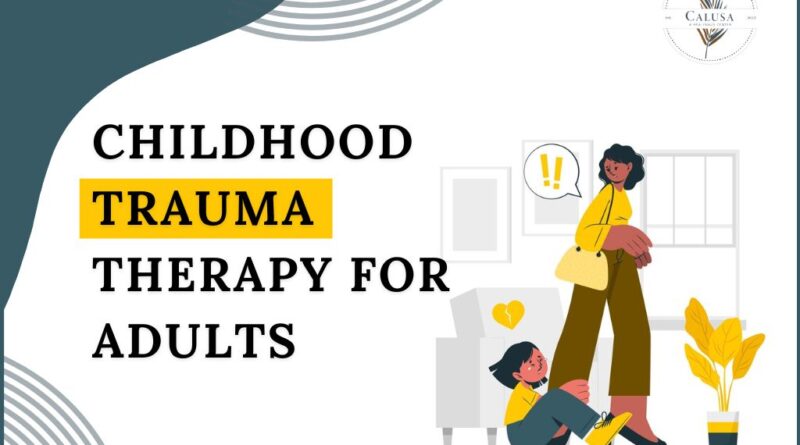Understanding Childhood Trauma Therapy: A Path to Healing
Childhood trauma is a deeply impactful experience that can shape a person’s mental, emotional, and physical well-being throughout their life. Whether it stems from abuse, neglect, loss, or witnessing traumatic events, childhood trauma leaves lasting scars. Childhoood trauma therapy provides a crucial space for individuals to process these experiences, heal, and rebuild a healthy future.
This article explores the significance of childhood trauma therapy, its benefits, and the therapeutic techniques used to facilitate recovery.
What Is Childhood Trauma?
Childhood trauma refers to any distressing or harmful event experienced during childhood that overwhelms a child’s ability to cope. The event may be physical, emotional, or psychological, but its effects can be profound and long-lasting. Some of the most common forms of childhood trauma include:
- Physical, emotional, or sexual abuse
- Witnessing violence or abuse
- Neglect or abandonment
- Loss of a caregiver
- Natural disasters or accidents
Trauma at a young age disrupts a child’s development and can lead to difficulties with emotional regulation, relationships, and self-esteem. These unresolved issues can continue into adulthood, affecting various aspects of life.
Why Childhood Trauma Therapy Is Important
Childhood trauma therapy plays a pivotal role in helping individuals address and overcome the challenges of their traumatic experiences. Here are several reasons why childhood trauma therapy is so important:
1. Healing Deep Emotional Wounds
Trauma often manifests in emotions like shame, anger, guilt, or fear, which can be overwhelming. Childhood trauma therapy helps individuals confront these emotions in a safe and supportive environment. By working through these emotions, individuals can begin to heal and rebuild their sense of self-worth.
2. Breaking the Cycle of Trauma
Without therapy, trauma can be passed down through generations. Unhealed trauma can lead individuals to replicate unhealthy behaviors in their own relationships and parenting. Therapy helps break this cycle by offering individuals the tools to heal and prevent further trauma from being passed along.
3. Improving Mental Health
Individuals with unresolved childhood trauma often struggle with mental health issues such as anxiety, depression, and post-traumatic stress disorder (PTSD). Therapy provides a structured and supportive environment to address these conditions, promoting better overall mental health and emotional stability.
How Childhood Trauma Therapy Works
There are various therapeutic approaches used in childhood trauma therapy to address the unique needs of individuals. Here are some of the most common and effective methods used to help individuals heal from childhood trauma:
1. Trauma-Focused Cognitive Behavioral Therapy (TF-CBT)
One of the most widely used therapies for childhood trauma, TF-CBT helps individuals change their negative thoughts and behaviors related to traumatic experiences. Through a combination of cognitive-behavioral techniques and trauma-specific interventions, TF-CBT enables individuals to process their trauma, learn new coping skills, and reduce emotional distress.
2. Eye Movement Desensitization and Reprocessing (EMDR)
EMDR is particularly effective for individuals suffering from PTSD or significant trauma-related symptoms. This technique involves using guided eye movements to help the brain reprocess traumatic memories, reducing their emotional charge. EMDR helps individuals transform the way they perceive traumatic memories, making them less distressing.
3. Play Therapy
Play therapy is often used for young children who may have difficulty expressing their feelings verbally. By engaging in play, children can communicate their thoughts and emotions, gaining insight into their inner world. This approach also helps children develop healthy coping skills, fostering emotional growth and resilience.
4. Narrative Therapy
Narrative therapy helps individuals reframe their trauma by viewing it as part of their larger life story. Through storytelling, individuals can detach from the trauma and gain perspective. By changing the narrative around their trauma, individuals can regain a sense of control and empowerment.
5. Somatic Experiencing
Somatic experiencing focuses on the body’s response to trauma. This therapeutic approach helps individuals become more aware of their physical sensations and how trauma manifests in the body. By releasing pent-up tension and stress, somatic experiencing can promote emotional healing and greater physical well-being.
The Benefits of Childhood Trauma Therapy
Engaging in childhood trauma therapy can offer a wide array of benefits for individuals. Here are some of the key advantages of therapy for childhood trauma:
1. Emotional Healing and Release
One of the primary benefits of therapy is emotional healing. By processing painful memories and emotions, individuals can gradually release the emotional weight they carry. Over time, this leads to a greater sense of peace and emotional freedom.
2. Improved Relationships
Unresolved childhood trauma can make it difficult to form healthy relationships. Therapy helps individuals understand how their trauma affects their interactions with others and provides tools to develop healthier communication patterns and trust in relationships.
3. Better Self-Esteem
Trauma often leads to feelings of unworthiness and shame. Childhood trauma therapy helps individuals rebuild their self-esteem by acknowledging their pain and affirming their worth. As individuals heal, they gain a greater sense of confidence and self-compassion.
4. Coping Mechanisms for Life’s Challenges
Childhood trauma therapy equips individuals with healthy coping mechanisms to navigate life’s challenges. By learning emotional regulation skills and stress management techniques, individuals are better able to face difficulties in a more balanced and resilient manner.
Choosing the Right Childhood Trauma Therapist
Finding the right therapist is essential for successful healing. Here are some tips for selecting the right childhood trauma therapist:
1. Specialization in Trauma
Look for a therapist who specializes in trauma recovery. Specializing in childhood trauma ensures that the therapist understands the complexities of the healing process and is equipped with the necessary tools and techniques.
2. Evidence-Based Approaches
Choose a therapist who utilizes evidence-based therapies such as TF-CBT, EMDR, or somatic experiencing. These approaches have been scientifically validated and are shown to be effective in treating trauma.
3. Comfort and Rapport
The therapeutic relationship is crucial for healing. Ensure that you feel comfortable and understood by your therapist. A safe, non-judgmental environment is essential for effective therapy and progress.
Conclusion
Childhood trauma can leave a lasting imprint on an individual’s life, but recovery is possible. Childhood trauma therapy offers a vital opportunity to process past experiences, heal emotional wounds, and build a brighter, healthier future. Whether through cognitive-behavioral therapy, EMDR, or other approaches, therapy provides the support needed to break free from the chains of trauma and reclaim control over one’s life. If you or someone you know is struggling with the effects of childhood trauma, seeking therapy is a powerful first step toward healing and transformation.




